Porsche Panamera S vs. BMW 750i, Maserati Quattroporte Sport GT S
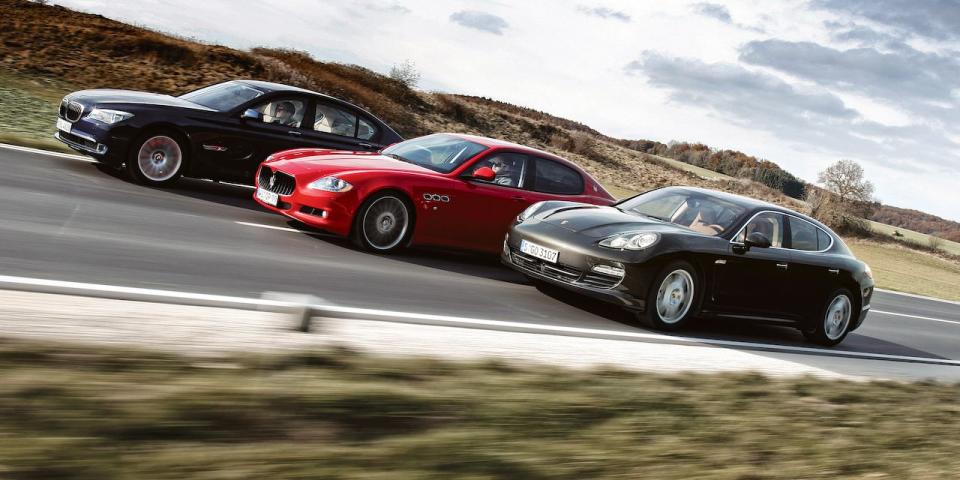

The Launch of the Panamera Comes During a Strange and Tumultuous Era at Porsche

Exhibit A: The German sports-car maker’s bestselling vehicle since 2003 has been a sport-utility vehicle, the Cayenne. Exhibit B: The car before you, the company’s first production sedan, is a further hyperextension of the Porsche lineup. Exhibit C: The attempt by Porsche to take over Volkswagen resulted in a perfect reversal of fortunes: Volkswagen took over Porsche. At which point, Porsche boss Wendelin Wiedeking was hurried off the premises, replaced by his right-hand man, Michael Macht.
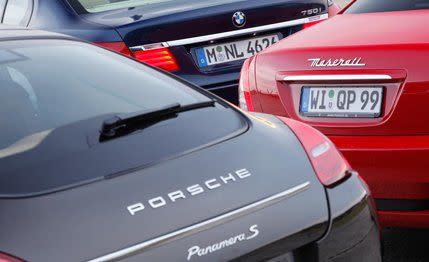
With the above in mind, you might think that Porsche is getting a little distracted, a bit off its game. Would the Panamera have the Porsche-ness—that magical sports-car sensitivity—to outdrive its increasingly fleet competition? That’s what we wanted to find out.
Its competitors are all European. Three Mercedes-Benzes would qualify for the job: the CLS63 AMG (same number of seats, similar dimensions—the car Wiedeking hoped to improve upon), the pricier S63 AMG (closer perhaps to the Panamera’s flagship, luxury-transport mission), and the E63 AMG wagon (same number of doors). But Mercedes begged off, skittish about pitting the aging CLS against this new Porsche. Complicating our selection process, a Mercedes S550 had recently been knocked off by a BMW 750Li, and the other logical competitor, the E63 wagon, may not even come to North America.
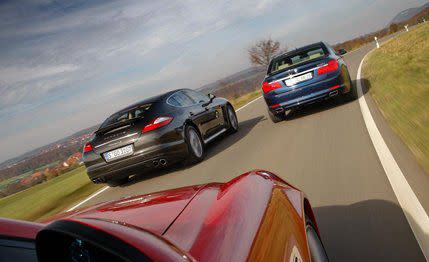
So we decided on two challengers for the new Porsche: a standard-wheelbase BMW 7-series and a Maserati Quattroporte. The Quattroporte got the invitation because we hadn’t had it in a comparo since one disposed of a Jaguar XJR and a Mercedes E55 AMG in 2004. Of three QP models, we chose the top Sport GT S because its 4.7-liter V-8 makes 433 horsepower, 37 more than a standard 4.2-liter Quattroporte, and it has the sportiest suspension. The Porsche and the BMW both make 400 horses.
We’d hoped to keep our entry-level Panamera reasonable—even $10,000 in options would have made it the least expensive car in the test—but, as usual, our rear-wheel-drive S model (base price: $90,775) was zooted up with more than $40,000 worth of options.
Still, the Maserati was the costliest, at $150,375. Our fully loaded BMW 750i checked in at $104,230, though it starts at $82,280.
We threw a six-pack of clean Jockeys and a stash of Altoids into a rucksack and jetted to Bavaria for a weeklong road bender. It’s fair to say we drove the spätzle out of these cars. Here is how they stack up.
Don’t be fooled by the Maserati’s third-place finish: It’s still an astounding car. It’s also the glamour puss of the three.
The Ferrari-derived V-8 at the heart of this Maser produces an exhaust note that’s like a Le Mans pit. At first, the ferocious noise is entertaining. But after a half-hour, the severe snap, crackle, and pop verges on the annoying, then becomes tiring. It’s so loud that drivers up ahead can hear it at cruising speeds. Thankfully, you can turn down the sound: We switched off the sport setting, which closes bypass valves in the exhaust system. This made long runs tolerable and kept our profile somewhat lower.
But what’s a guy to do? A study by a British insurance group in 2008 shows that women who heard the soundtrack of a Maserati’s V-8 became aroused. (The test’s psychologist explained that the “roar of a luxury-car engine actually does cause a primeval physiological response.”)
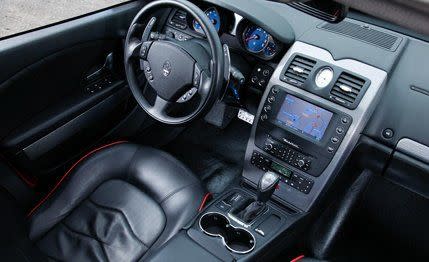
The fun doesn’t stop at the ears. It can be felt in the rump, too. A 0-to-60-mph dash of 4.5 seconds and a quarter-mile in 13.1 seconds bests the Panamera and the BMW. It is also quicker than the one-step-down Quattroporte S, by 0.3 second to 60 and 0.4 second in the quarter-mile.
In spirited driving over winding roads, the QP exhibits the most body roll of the three, possibly because it’s the only one without an adjustable suspension. Maserati dumps the adaptive magnetorheological shocks in the standard QP for single-rate dampers in the Sport GT S, lowers the ride height, and fits stiffer springs. The result is a sport-dedicated suspension that rides well, especially considering its 20-inch wheels, largest of the group. Despite the extra pitch, the QP hustles through corners. It became our favorite on switchbacks because it offers the best forward sightlines and has excellent, plantain-size paddle shifters. It also has the most organic steering feel, though effort is on the light side. Both the BMW and the Porsche have variable-ratio steering, which, especially in the BMW, filters out some linearity at the helm.
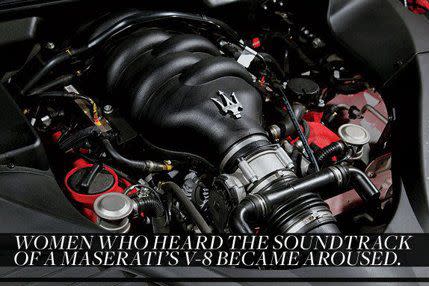
The interior feels and looks a bit dated, though it is covered in supple, luxurious leather, and the car lacks in the “features and amenities” department (see Final Results chart). That said, the Maserati has the most emotional appeal: It feels less like an engineering masterpiece and more like a work of art.
This BMW looks big even though it’s shorter than the Maserati and not as wide as the Porsche. At 58.3 inches high, however, it is the tallest of the three. It appears completely unsporting and ordinary when resting next to the Maserati and even the Porsche. The previous 7-series was a victim of Chris Bangle’s design philosophy, with slashed sheetmetal and swooping fenders that made BMW’s business vessel look like too much of a caricature. As a result, this 7 was designed with a more conservative, boardroom approach than the mangled Bangle of the past.
Looks can be deceiving, though. With a turbocharged 400-hp V-8 that is admirably lag-free, the big BMW seems to shrink in size as speeds increase and driver confidence grows, some achievement for a 4475-pound car. This is a Saint Bernard–size chassis that thinks it’s a border collie. Attribute much of that to the 750i’s dynamic anti-roll bars, rear-wheel steering, and variable-rate dampers that act on both rebound and compression. The variable-ratio rack and rear-wheel steering combine for an artificial feel transmitted through the wheel. This can become alarming when you’re pushing the car hard because it allows it to rotate more immediately. It takes some getting used to, but it’s surprisingly effective.
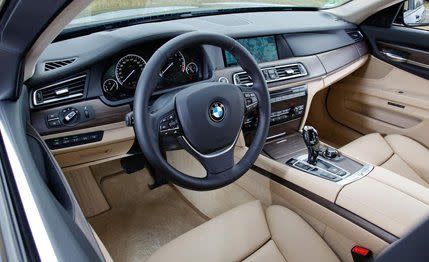
The 19-inch run-flat Goodyears fitted to the 750i are tuned for comfort relative to the sports-car-bred Michelin Pilot Sport PS2s on the Porsche and the Maserati’s Pirelli P Zeros. Despite the tire handicap, the BMW managed a respectable 67.6 mph through the lane-change maneuver, although that was poorest in test, and 0.87 g on a small, 150-foot-diameter skidpad. Stopping from 70 mph was weakest in test, too, at 162 feet, which was five feet more than the QP and four more than the Porsche. The BMW was also the heaviest and paid its price for that in straight-line tests. It took 5.2 seconds to hit the 60-mph mark from rest, which was 0.7 second behind the Maserati. But by the time the cars got to the quarter-mile, the gap had shrunk to 0.5 second, with a time of 13.6 seconds for the BMW.
When we tried to play tag in the hills with the Maser and the Porsche, the Bimmer was hindered by its lack of paddleshifters. It would approach a corner in too high a gear, so we would find ourselves groping for the joystick-like shifter in the center console to drop a couple of gears, only to have the transmission hesitate occasionally while the lead car pulled away.
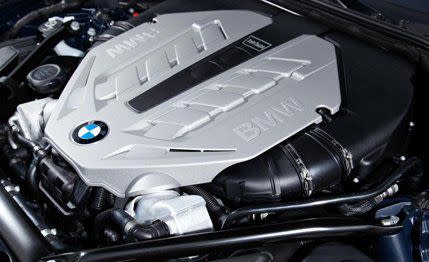
However, there are no compromises in luxury or amenity. The back seat is both largest by volume and the most comfortable; it’s the only car that pleasantly accommodates three grown-ups. (The Panamera is for two only.) The BMW is also the quietest, whether at idle, full throttle, or a 70-mph cruise. Most owners will not take the car to our extremes but will enjoy it for the expensive commuter that it is. Still, it does have a true sporting side, which is a great byproduct of a thoroughly engineered car.
Gentlemen and ladies, get your pens out because we have another C/D comparo that has been decided by just a few points. As a caveat, take note that we no longer have the oft-reviled “gotta have it” category baked into our evaluations. After so many scornful missives contending that this was a not-very-clever way to cook the books, we dumped it, redistributing some points to fuel economy as well as steering and brake feel. But the 25-point “fun to drive” category stays.
The Panamera’s styling has failed to win us over despite repeated encounters with the car. It’s hulky and bulky, and from behind, it seems to be retaining water. This hatchback has a grand amount of room for full-size adults and their luggage—but seating in back is for two only, and its rear seats are the narrowest of the three cars here, hence the low scores for rear-seat comfort and space.
From the inside looking out, the Panamera feels low and wide, and its cockpit is the most attractively designed. However, the corners of the car can be difficult to see while parking, and the high beltline and raked styling can make the cabin feel claustrophobic at times. At night, the headlights of cars approaching from behind suddenly disappear behind the rear shelf and the C-pillars. And with the optional noise-insulating glass ($1120), those cars become not only invisible but stealthily silent.
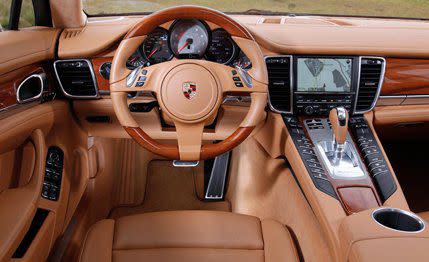
We anticipated that the Panamera would get the best fuel economy as it is the only one of the three not slapped with a gas-guzzler tax, which ranges from $1000 to $7700 on cars that achieve less than 22.5 mpg on the EPA’s unadjusted combined scale. However, we were pleasantly surprised by a figure of 19 mpg over 450 miles of varied driving that included autobahn speeds up to 150 mph. That’s 36 percent better fuel economy than the next-best BMW’s 14 mpg.
The good gas mileage was possible partly because the Porsche has a start-stop feature, which allows it to save fuel by shutting off its engine instead of idling when it comes to a stop. The engine refires when the driver releases the brake pedal. Interestingly enough, U.S.-market Panameras all come with this feature, but owners will have to toggle it on every time they start the car. Because the on position is not default, the EPA did not enable it for the city portion of its fuel-economy testing. With the start-stop disabled, the EPA rates the Panamera at 16 mpg in the city.
But, like being the world’s most famous golfer, there’s an upside and a downside to this feature. When the car comes to a stop and the 400-hp, 4.8-liter V-8 takes its sabbatical, the engine restart is cumbersome, and switching from brake to throttle too quickly causes the car to lurch. Releasing the brake and letting the engine settle down from its restart before rolling into the throttle will save you some frustration and even a little more gasoline.
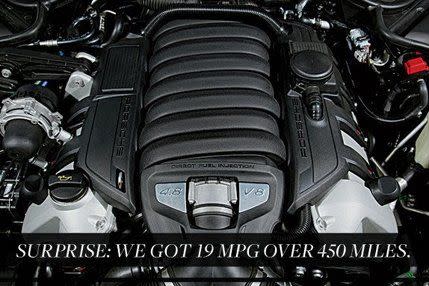
The Panamera’s stellar seven-speed, dual-clutch automated manual should be a benchmark for transmission makers. Shifts are brisk and sometimes even unnoticeable in the least-sporting of the three settings, which are normal, sport, and sport plus. In sport plus, the transmission chooses the lowest possible gear, which reduces the need to use the confusing and redundant push-pull shifters on the three- and nine-o’clock spokes of the steering wheel.
Unfortunately, about the only option not tacked onto our test car was the $1320 Sport Chrono package, which includes launch control. Even without it, the Panamera was plenty quick: just a tick off the Quattroporte’s 0-to-60-mph sprint and quarter-mile mark, at 4.6 and 13.2 seconds, respectively.
But our biggest question surrounding the Panamera was how Porsche would supply this 4101-pound gorilla with the handling and agility we have come to expect of its cars. On initial turn-in, this four-passenger sedan reacts with piggish understeer: no surprise there. But a blink later, the tires seem to extend some traction spikes and dig into the road, contradicting any countermeasures the driver might have already taken against the understeer. This trait made the lane-change test slightly spooky because the car felt like it would be sliding off line and would then regain grip just in time to power through the finish gate. Ultimately, though, the Panamera is seriously capable, clocking 69.1 mph in this test, a feat that’s nothing short of astonishing for a 76.0-inch-wide car. The Panamera was second on the skidpad, at 0.90 g, trailing the Maser by a scant 0.01 g.
Quirky turn-in and all, the Porsche is capable of walking away from the others on back-road blasts; it just takes a bit of confidence in the car’s ability. Applying post-corner power is possible earlier than with the BMW and is without the occasional, but entertaining, power oversteer of the Maserati.
The Panamera triumphs because it’s the best compromise of luxury and sport. It’s not as visceral as the Maserati or as luxurious as the BMW, but it drives as a Porsche should—i.e., it’s still exhilarating—and delivers Porsche-level performance. It also has a gorgeous interior and feels the most hooked up of the group. Too bad about the way it looks, but you won’t care from the driver’s seat.
You Might Also Like

 Yahoo Autos
Yahoo Autos 